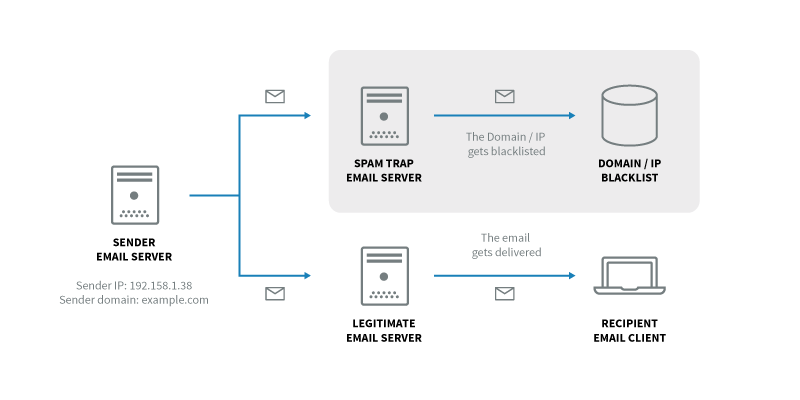Updated: July 30, 2021
We’ve all been there. You diligently plan your campaign for months and have all the emails ready and then you hit send only to realize: wait, you’re getting ¼ as many opens as you normally do.
That probably means you got blacklisted. We’re here to show you how to check if your mail server is blacklisted.
It’s a simple 1-2-3 process, so let’s get to it!

1. Find Out What Type of Blacklisting You’re Probably Facing
There’s not just one type of blacklisting you might be faced with. There are many. Let’s go one by one:
a) Public Blacklists
PRO: easy to check
CON: some are near-impossible to remove
Public blacklists are the most common. They include but are not limited to:
- Spamhaus
- Microsoft
- URIbl
- UCEProtect
- SORBS
- Composite
The entire list of public blacklists goes up to about 160.
Why am I on this blacklist? You’re typically put on public blacklists if you send too many marketing or outreach emails. Spamhaus, for instance, has the mission of “identifying and pursuing spam” to make inboxes cleaner and safer.
b) Enterprise Blacklists & Spam Firewalls
PRO: easy to check
CON: can also blacklist your website based on links inside your emails
Simply put, enterprise firewalls are proprietary directories of spam websites that corporate IT departments simply love to use. Ergo these types of blacklists are particularly harmful to B2B companies.
Here’s a list of the most common (plus links to their directories where you can check):
There are more but those are typically more obscure.
Why am I on this blacklist? Again — if you’re sending a lot of emails, your reputation is suffering, and your server might be blacklisted or, alternatively, with this particular blacklist type, your domain (website) might be blacklisted. If you’re inserting 30 links to your website in three emails per week, chances are you’re on one of these.
c) ISP Blacklists & Private Blacklists
PRO: generally less harmful than the previous two, can still hurt your campaigns a lot
CON: almost impossible to check for some
Most serious ISPs have their own lists of spammy servers that they blacklist and the worst part is the majority don’t even allow you to check. The same goes for major MSPs like:
- Yahoo
- Outlook
Why am I on this blacklist? If you’ve sent oodles of emails, all with links, to email addresses registered with Google, Yahoo, Outlook (or most ISPs), chances are that’s enough to get you blacklisted.
2. Gather All the Data You Need
To check whether you’ve been blacklisted or not (on public blacklists and enterprise firewalls), you have to be ready with the following things:
- IP Address of your server
- Domain
- The emails used as senders
Make sure you find the correct IP address. Alternatively, you want to check if you’re repeatedly linking to a spammy domain. Prepare a list of domains you are often linking to and check those as well. If any of those turn out to be blacklisted, remove them from all your future emails ASAP.
Remember: any mention or link to a blacklisted domain can potentially lead to issues with your emails, so don’t ignore the domains you’re linking to. One common culprit to check is the signature, as many corporate templates may contain links to affiliated or child companies that have been blacklisted.
3. Check If You’re on Public Blacklists with One of these Tools
Since it’s the internet, of course, there are tools specially designed to check if you’ve been put on multiple blacklists at the same time.
Below, you’ll find the most common, but you’ll want to manually check all the other lists we’re blacklists we’ve linked to above!
4. (Optional) Take Some Extra Steps OR Change Your Email Server
Just because you’re not on any of these doesn’t mean you haven’t been blacklisted. Last we checked, there are 160 public blacklists and counting.
So if you’re seeing diminishing returns from your email campaigns and are at a loss as to what might’ve caused them, our advice would be to err on the side of caution and do the following:
- For blacklists that don’t give you the option to check, hunt for the right email address (either the abuse account or the postmaster/root) and send an inquiry that way.
- Be nice in your inquiries (very important!)
- Search the web for details related to your domain and your email server
- Manually check if you are blacklisted through our article on what to do if you are blacklisted
- If you’ve exhausted all your options, there’s nothing left to do other than to change your email server (sorry) and possibly your domain (yep!)
How to Avoid Getting Listed on an Email Blacklist
So, next time, be extra careful how you send emails and make sure you take the right precautionary steps to proactively avoid getting blacklisted. It helps if you visualize exactly how spam emails are trapped:

It might be tempting to send 5 emails per week, each with 5 articles from your blog, two product ads, and a bunch of links in the footer. However, at the end of the day, it’s going to cost you precious time, and potentially your entire email marketing tactic will become completely useless for the foreseeable future.
Spam complaints are treated very seriously by email servers and clients: if enough people that receive your email believe it’s spam and click the “spam” button, then you will likely show up in one or more of the lists we mentioned above.
Think: do I really need to send out all that spam? Because a little bit of extra caution never hurt anyone.
Any Other Issues?
How this cleared up how you check if your mail server is blacklisted. For any other issues related to email blacklisting and email servers, be sure to check out the Axigen blog for regular updates.